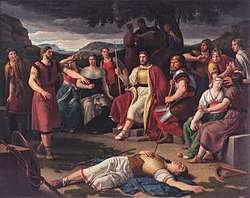Ainur (Middle-earth)
The Ainur (singular: Ainu) are the immortal spirits existing before Creation in J. R. R. Tolkien's fictional universe. These were the first beings made of the thought of Eru Ilúvatar. They were able to sing such beautiful music that the world was created out of it.[T 1]
Fictional history
Before the Creation, Eru Ilúvatar made the Ainur or "holy ones".[T 1] The Universe was created through the "Music of the Ainur" or Ainulindalë, music sung by the Ainur in response to themes introduced by Eru. This universe, the song endowed with existence by Eru, was called Eä in Quenya. The Earth was called Arda.[T 1] Those of the Ainur who felt concern for the Creation entered it, and became the Valar and the Maiar, the guardians of Creation.[T 2]
The Vala Melkor claimed the Earth for himself. His brother, Manwë, and several other Valar decided to confront him. Melkor fell into evil and became known as Morgoth, the dark enemy. The conflict between the Valar and Morgoth marred much of the world. According to The Silmarillion, the Valar and Maiar—with the aid of the Vala Tulkas, who entered the Creation last—succeeded in exiling Morgoth into the Void, though his maleficent influence remained ingrained in the fabric of the world.
Reception

Norse Æsir
Critics have noted that the Valar resemble the Æsir, the gods of Asgard.[1] Thor, for example, physically the strongest of the gods, can be seen both in Oromë, who fights the monsters of Melkor, and in Tulkas, the strongest of the Valar. Manwë, the head of the Valar, has some similarities to Odin, the "Allfather",[2] while the wizard Gandalf, one of the Maiar, resembles Odin the wanderer.[3]
Christian angels

The theologian Ralph C. Wood describes the Valar and Maiar as being what Christians "would call angels", intermediaries between the creator, named as Eru Ilúvatar in the Silmarillion, and the created cosmos. Like angels, they have free will and can therefore rebel against him.[4] Grant C. Sterling, writing in Mythlore, states that the Maiar resemble the Valar in being unable to die, but differ in being able to choose to incarnate fully in forms such as men's bodies. This means that, like Gandalf and the Balrogs, they can be killed. He notes that Sauron's inability ever to take bodily form again after his defeat could be the result of having given his power to the One Ring, but that the fate of killed Maiar remains unclear.[5] Jonathan Evans, writing in the J.R.R. Tolkien Encyclopedia, calls the Maiar semidivine spirits, and notes that each one is linked with one of the Valar. He states that they have "perpetual importance in the cosmic order", noting the statement in the Silmarillion that their joy "is as an air that they breathe in all their days, whose thought flows in a tide untroubled from the heights to the deeps."[6][T 3] Evans notes, too, that Arien and Tilion are central in Tolkien's myth of the Sun and Moon.[6]
In culture
In astronomy, the Kuiper belt object 385446 Manwë is named for the king of the Valar.[7]
References
Primary
- This list identifies each item's location in Tolkien's writings.
- The Silmarillion, "Ainulindale"
- The Silmarillion, "Valaquenta"
- Silmarillion, "Quenta Silmarillion", 10. "Of the Sindar"
Secondary
- Garth, John (2003). Tolkien and the Great War: The Threshold of Middle-earth. Houghton Mifflin. p. 86. ISBN 0-618-33129-8.
- Chance, Jane (2004). Tolkien and the Invention of Myth: A Reader. Lexington, Kentucky: University Press of Kentucky. p. 169. ISBN 0-8131-2301-1.
- Jøn, A. Asbjørn (1997). An investigation of the Teutonic god Óðinn; and a study of his relationship to J. R. R. Tolkien's character, Gandalf. University of New England.
- Wood, Ralph C. (2003). The Gospel According to Tolkien. Westminster John Knox Press. p. 13. ISBN 978-0-664-23466-9.
- Sterling, Grant C. (1997). "The Gift of Death". Mythlore. article 3. 21 (4): 16–18.CS1 maint: location (link)
- Evans, Jonathan (2013) [2007]. "Maiar". In Drout, Michael D. C. (ed.). J.R.R. Tolkien Encyclopedia: Scholarship and Critical Assessment. Routledge. pp. 401–402. ISBN 978-0-415-86511-1.
- "385446 Manwe (2003 QW111)". Jet Propulsion Laboratory. Retrieved 16 May 2020.
385446 Manwë Discovered 2003 Aug. 25 by M. W. Buie at Cerro Tololo. Secondary (385446) I = Thorondor discovered in 2006 by K.S. Noll et al. using the Hubble Space Telescope. In J.~R.~R. Tolkien's mythology, Manwë is foremost among the deities who rule the world.
Sources
- Tolkien, J. R. R. (1977), Christopher Tolkien (ed.), The Silmarillion, Boston: Houghton Mifflin, ISBN 0-395-25730-1